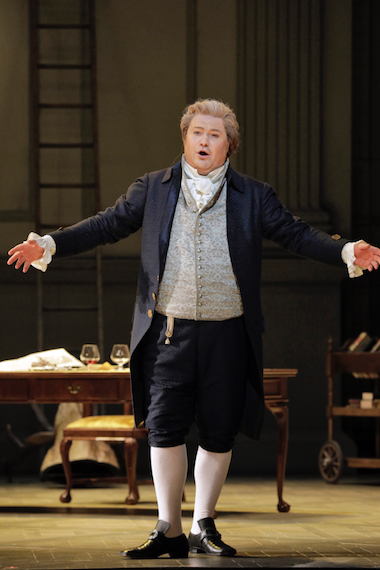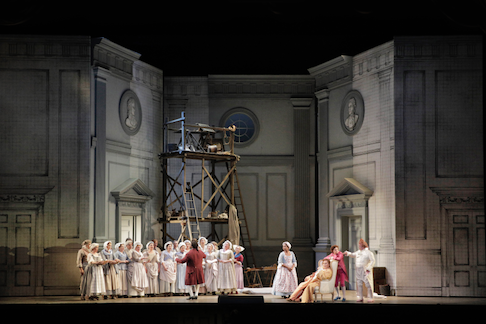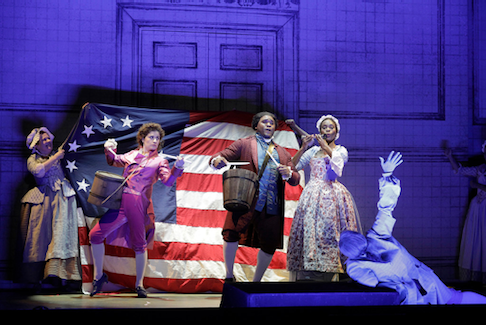
20 Oct 2019
The Marriage of Figaro in San Francisco
San Francisco Opera rolled out the first installment of its new Mozart/DaPonte trilogy, a handsome Nozze, by Canadian director Michael Cavanagh to lively if mixed result.
English Touring Opera are delighted to announce a season of lyric monodramas to tour nationally from October to December. The season features music for solo singer and piano by Argento, Britten, Tippett and Shostakovich with a bold and inventive approach to making opera during social distancing.
This tenth of ten Live from London concerts was in fact a recorded live performance from California. It was no less enjoyable for that, and it was also uplifting to learn that this wasn’t in fact the ‘last’ LfL event that we will be able to enjoy, courtesy of VOCES8 and their fellow vocal ensembles (more below …).
Ever since Wigmore Hall announced their superb series of autumn concerts, all streamed live and available free of charge, I’d been looking forward to this song recital by Ian Bostridge and Imogen Cooper.
Although Stile Antico’s programme article for their Live from London recital introduced their selection from the many treasures of the English Renaissance in the context of the theological debates and upheavals of the Tudor and Elizabethan years, their performance was more evocative of private chamber music than of public liturgy.
Evidently, face masks don’t stifle appreciative “Bravo!”s. And, reducing audience numbers doesn’t lower the volume of such acclamations. For, the audience at Wigmore Hall gave soprano Elizabeth Llewellyn and pianist Simon Lepper a greatly deserved warm reception and hearty response following this lunchtime recital of late-Romantic song.
For this week’s Live from London vocal recital we moved from the home of VOCES8, St Anne and St Agnes in the City of London, to Kings Place, where The Sixteen - who have been associate artists at the venue for some time - presented a programme of music and words bound together by the theme of ‘reflection’.
'Such is your divine Disposation that both you excellently understand, and royally entertaine the Exercise of Musicke.’
‘And there was war in heaven: Michael and his angels fought against the dragon; and the dragon fought and his angels, And prevailed not; neither was their place found any more in heaven … that old serpent … Satan, which deceiveth the whole world: he was cast out into the earth, and his angels were cast out with him.’
There was never any doubt that the fifth of the twelve Met Stars Live in Concert broadcasts was going to be a palpably intense and vivid event, as well as a musically stunning and theatrically enervating experience.
‘Love’ was the theme for this Live from London performance by Apollo5. Given the complexity and diversity of that human emotion, and Apollo5’s reputation for versatility and diverse repertoire, ranging from Renaissance choral music to jazz, from contemporary classical works to popular song, it was no surprise that their programme spanned 500 years and several musical styles.
The Academy of St Martin in the Fields have titled their autumn series of eight concerts - which are taking place at 5pm and 7.30pm on two Saturdays each month at their home venue in Trafalgar Square, and being filmed for streaming the following Thursday - ‘re:connect’.
The London Symphony Orchestra opened their Autumn 2020 season with a homage to Oliver Knussen, who died at the age of 66 in July 2018. The programme traced a national musical lineage through the twentieth century, from Britten to Knussen, on to Mark-Anthony Turnage, and entwining the LSO and Rattle too.
With the Live from London digital vocal festival entering the second half of the series, the festival’s host, VOCES8, returned to their home at St Annes and St Agnes in the City of London to present a sequence of ‘Choral Dances’ - vocal music inspired by dance, embracing diverse genres from the Renaissance madrigal to swing jazz.
Just a few unison string wriggles from the opening of Mozart’s overture to Le nozze di Figaro are enough to make any opera-lover perch on the edge of their seat, in excited anticipation of the drama in music to come, so there could be no other curtain-raiser for this Gala Concert at the Royal Opera House, the latest instalment from ‘their House’ to ‘our houses’.
"Before the ending of the day, creator of all things, we pray that, with your accustomed mercy, you may watch over us."
The doors at The Metropolitan Opera will not open to live audiences until 2021 at the earliest, and the likelihood of normal operatic life resuming in cities around the world looks but a distant dream at present. But, while we may not be invited from our homes into the opera house for some time yet, with its free daily screenings of past productions and its pay-per-view Met Stars Live in Concert series, the Met continues to bring opera into our homes.
Music-making at this year’s Grange Festival Opera may have fallen silent in June and July, but the country house and extensive grounds of The Grange provided an ideal setting for a weekend of twelve specially conceived ‘promenade’ performances encompassing music and dance.
There’s a “slide of harmony” and “all the bones leave your body at that moment and you collapse to the floor, it’s so extraordinary.”
“Music for a while, shall all your cares beguile.”
The hum of bees rising from myriad scented blooms; gentle strains of birdsong; the cheerful chatter of picnickers beside a still lake; decorous thwacks of leather on willow; song and music floating through the warm evening air.

San Francisco Opera rolled out the first installment of its new Mozart/DaPonte trilogy, a handsome Nozze, by Canadian director Michael Cavanagh to lively if mixed result.
It was off to a good start with its show curtain, a huge architectural drawing detail of a corinthian capital aside a partial façade, slowly morphing, videographically, into a fully realized façade elevation (drawing) of the aristocratic home we were about to enter. This occurred in precise, riveting synchrony to Mozart’s well-conducted overture. It was a visual distraction, very finely and thoroughly done, making apparent that the evening was not to be about Mozart’s hallowed score.
It was about the house we entered, essentially the world and its order (the droit du seigneur) that had been constructed in front of our eyes. And its noisy inhabitants, lots of them, in the act of moving in. While the house was slowly making itself ready for its entering occupants their worlds began falling apart. Finally, very late in the evening, we arrived at the perfectly finished garden where everyone, absolutely everyone’s world did indeed fall apart. Including Mozart’s.
 Act I, with construction scaffolding
Act I, with construction scaffolding
The inhabitants seemed fairly random. A Hungarian Count, a South African Susanna, an Italian Cherubino, a Countess coming via Houston (where else?). Bartolo, Marcellina and Basilio were summoned from the Opera’s warehoused treasury of singers. And there was Figaro, baritone Michael Samuel, who held it all together with musical aplomb, and a dignity that was sorely missing from everyone else. That was director Cavanagh’s point.
It was an avoidance of the perfection that we anticipate in a Mozart DaPonte opera production, a world we cherish for its rarified, distilled emotion and high moral and musical concept. Instead it was an imagined, rowdy world of Beaumarchais’ pre-revolutionary France and its hero Figaro. And a catch-all of opera casting.
Starting with Count Almaviva, sung by Budapest Opera’s Levente Molnar who chased a fly around the room in his famed “Hai gia vinta la causa.” Mr. Molnar, a fine singer who well intoned the showpiece, is an accomplished dead pan comedian. Light on his feet, exposed, he collapsed in a heap onto the floor to beg the Countess’ forgiveness. The Countess, sung by soprano Nicole Heaston, was simply overwhelmed by it all. Lost in the impressive, expansive confines of her new home, in beautiful voice she gave us a lonely "Dove sono i bei momenti” threatening to fall below pitch in her depression, aided by the conductor who provided unsustainable tempos.
Susanna, sung by soprano Jeanine de Bique of small voice and great big presence, blatantly teased the Count and Figaro and everyone else, and in general displayed a lot of attitude about most everything. She was at her wit’s end in the third and fourth acts, coping, it seemed, as best she could, vocally and emotionally. Figaro, baritone Samuel, was the moral conscience of Beaumarchais’ revolutionary world, a conspirator with Mozart in an intense emotional world, and the one character who grounded director Cavanagh’s raucous household through the innately solid musical and vocal confidence he displayed in his first act aria “Se vuol ballare signor contino” and his last act aria “Aprite un po' quegli occhi.”
Cherubino, sung by Serena Malfi, was the star turn of the casting, her Cherubino is present on the world’s major stages. Here very unlike the sweet energy and innocence of Federica von Stade’s renowned Cherubino, Mlle. Malfi’s Cherubino was a true boy brat, persistently annoying throughout the opera, akin to the fly Almaviva chased around his study. With her famed “Non so piu cosa son” Mlle. Malfi made it clear she could do just about anything with her character, including coping with some weird tempos imposed by the conductor.
Of utter perfection were the Marcellina of Catherine Cook and the Basilio of Greg Fedderly, well known in these roles in previous San Francisco Opera Nozze incarnations. But here their delightful, heavy caricatures of Mozart’s subversive characters were a bit out of place in the grittiness of the production, with Mr. Fedderly’s costume surely borrowed from a Cunning Little Vixen production. Bass James Creswell was over-parted as Bartolo, this character needing a warmth and strength of personality that Mr. Creswell did not find.
A big player in Mr. Cavanagh’s destruction of our expectations was Hungarian conductor Henrik Nánási, last heard in San Francisco conducting the ninety-some players of the 2017 Elektra. Mo. Nanasi is not an early music conductor, nor is the San Francisco Opera Orchestra a period instrument ensemble, attributes that might have played more appropriately with this irreverent take on the Mozart masterpiece. The 45 players of the Opera orchestra created a very present, appealing sound that challenged our sense of balance with the generally smaller-voiced cast, voices appropriate to more intimate European Italian style theaters. Well, except for the voice of Adler Fellow Natalie Image’s Barbarina that filled the 3200 seat War Memorial to its brim.
But the maestro did often fall into a wonderful flowing lyricism that promised and delivered great musical reward for the Mozart heroines of the evening. Unfortunately Mo. Nanasi acceded to the temptation to drag out this wonderful lyrical atmosphere with excessive retardandos in the final moments of the arias.
It all went well until the fourth act when in our exhaustion (there were intermissions after both Act 1 and II, usually united) we were ready for some Mozartian emotional and musical idealism that could bring Beaumarchais’ troubled characters as envisioned by director Cavanagh some peace. This was not to be. Both stage director and conductor had shot their wads by that point, and glibly wrapped up this monument to 18th century Enlightenment as quickly and efficiently as they could.
With set designer Erhard Rom director Cavanagh created a setting that was fully 18th century in image and fully 21st century in technique with the set participating in the action — a three section wall with a door fell from time to time, all or in part, to isolate a singer or a scene on the stage apron creating a new, stronger focus on the moment. Lighting designer Jane Cox used modified versions of avant garde lighting cliches to amusing effect.
 Cherubino marching off to America, Figaro on drums, Susanna on fife
Cherubino marching off to America, Figaro on drums, Susanna on fife
Director Cavanagh exposed great wit non-stop throughout the evening, with inspired ideas like sending Cherubino off to join French general Lafayette in America, with piquant moments like the prompter reaching out of his box to fetch the jar the Count had used to briefly imprison the fly, and with weirdness like Curzio, sung by tenor Brenton Ryan, insanely writhing in the doorways during the wedding minuet. The plethora of choreographed gags sometimes flowed impeccably, and sometimes did not.
All in all it a was an auspicious debut for the Michael Cavanagh Mozart DaPonte trilogy.
Michael Milenski
Cast and production information:
Figaro: Michael Sumuel; Susanna: Jeanine De Bique; Count Almaviva: Levente Molnár; Countess Almaviva: Nicole Heaston; Cherubino: Serena Malfi; Doctor Bartolo: James Creswell; Marcellina; Catherine Cook; Don Basilio: Greg Fedderly; Don Curzio: Brenton Ryan; Barbarina: Natalie Image; Antonio: Bojan Knežević. Chorus and Orchestra of the San Francisco Opera. Conductor: Henrik Nánási; Director: Michael Cavanagh; Set Designer: Erhard Rom; Costume Designer: Constance Hoffman; Lighting Designer: Jane Cox; Choreographer: Lawrence Pech. War Memorial Opera House, San Francisco. October 16, 2019.